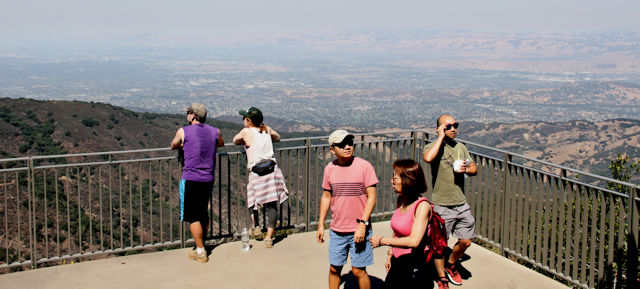You might think that Labor Day Weekend is perhaps not the ideal time to visit Silicon Valley’s Silent Sentinel from the Cold War era, but my wife thought so. And so we went. The Sentinel is a large, multi-story, concrete tower that looms over the southern part of Silicon Valley. I looked at it frequently when I worked at Xilinx in South San Jose. It’s quite visible from the campus.
That immense box sitting atop Mt. Umunhum is easy to see from a wide swath of the valley.
And that was the whole point because that grey box, a crumbling concrete structure, was part of the Almaden Air Force Station. It needed a commanding view because the concrete box supported an immense radar antenna that scanned the skies for Soviet Bear bombers coming over the horizon from the west. This particular station became operational in 1957, so it was watching the skies back when I was being taught that hiding under my student desk and putting my head between my knees was an effective defense against multi-megaton nuclear weapons. This radar installation is one of the reasons why that theory was never tested.
The radar tower atop Mt. Umunhum was one of many similar radar stations dotting the California coast, and part of a system that stretched across the US. These radar towers, and more, fed the SAGE (Semi-Automatic Ground Environment) defense system. By the time the SAGE system was fully deployed in 1963, the system consisted of 24 SAGE Direction Centers, three SAGE Combat Centers, and more than 100 interoperating air defense elements spread throughout the US, each linked together by long-distance telephone lines. This was a computer-and-sensor system built on an utterly fantastic scale for the times. In many ways, SAGE was the prototype for the IoT, but built long before that was an Internet.
Each SAGE Combat Center was built around a dual-redundant A/N FSQ-7 computer, incorporating approximately 60,000 vacuum tubes, burning 3 megawatts of power, and running the largest computer program written to date (some 500,000 lines of code including the world’s first RTOS). The design of the A/N FSQ-7 computer was a direct outgrowth of the MIT Whirlwind project and used newfangled magnetic core memory, which took over from the extremely quaint Williams-Kilburn tube memory. (Storage in the Williams-Kilburn tube, which was a CRT, employed phosphor-dot persistence as the memory storage element, so it was—in a sense—the granddaddy of DRAM, which also required refresh cycles.)
MIT selected IBM as the prime contractor for the SAGE computer systems. The project transformed IBM from the world’s leading vendor of punched card tabulation machinery into the world’s leading computer maker. According to IBM, the SAGE project generated 80% of the company’s revenues from computers between 1952 and 1955. More than 7000 IBMers were involved in the project by 1958. The SABRE airline reservation system, also built by IBM during the same period, was largely based technology developed for SAGE.
With all of that amazing 1950s technology, you might think that SAGE had a long and useful life. In reality, the full system was obsolete almost from the day it was switched on. SAGE was designed to protect against attack by bomber aircraft. By the early 1960s, the threat from bombers still existed but was overshadowed by the threat from ICBMs. SAGE was not designed to protect against threats from ballistic missiles. Nevertheless, SAGE and the radar tower atop Mt. Umunhum remained operational until the early 1980s. (Note: Bits and pieces of a decommissioned SAGE A/N FSQ-7 computer have appeared in television shows and movies since the 1960s including Irwin Allen’s Time Tunnel series and two Austin Powers movies.)
These days, the giant concrete sentinel on Mt. Umunhum is part of the Midpenninsula Open Space’s Mt. Umunhum – Sierra Azul park. It’s a winding 10-mile drive via Hicks Road to Mt. Umunhum Road from Camden Ave in south San Jose. There’s a large parking lot at the top, from which you need to climb another 159 concrete steps to achieve the summit where the sentinel sits. There are a very few handicap parking spaces at the summit as well as a drop-off point. At the summit, you can see the silent SAGE sentinel as well as a stunning view of Silicon Valley, which is currently marred by smoke from the wildfires raging in northern California.
The parking lot just below the summit was nearly empty on the Sunday we visited but you can’t count on that. Also, you should know that the park closes half an hour after sunset.

As we were leaving, two motorcycles rolled up. The rider of a blue and white Harley stopped next to me and pointed to the silent sentinel. “Do you know what that is?” he asked. At first, I thought he was kidding. But he wasn’t. He did want to know.
So I told him the stories.
(Image credits: Steve Leibson)




